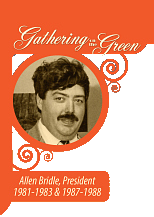The 1970s had set the stage for the Society's growth in the 1980s. The last remnants of the Winnacunnet Plantation were removed, sales of Dow's History of Hampton continued to fund improvements, the Salty Marsh Garden Club planted flowers to beautify the grounds, and summer visitors flocked to the Museum now that the oil crisis of the '70s was over.
Donations of historical items poured in and the Museum was once again running out of space. To make more room, for the first time the Society pondered ending the tenant-custodian arrangement that had been in place since 1925. As a potential new exhibit space the Society asked to use the garage where the Town stored its groundskeeping equipment.
The Town agreed to move if the Society would build a shed for the equipment, which it did. The Board of Directors then began fundraising and renovating the garage to display its collection of farming tools. In 1989 the Farm Museum was dedicated.
Frances Souther, daughter of Hampton-raised artist Charles Henry Turner (1848-1908), donated several of his paintings and 18th century furniture from the Goss-Turner house in Hampton. In 1988 the Society participated in the Town's 350th anniversary, and dedicated the General Moulton monument at Pine Grove Cemetery and the new
Fire Museum built by Hampton firefighters. The Society moved
Norseman's Rock from its spot near the seashore to the Museum grounds. Summer hours at the Museum were changed from 7 days a week to 4 days, with a slight increase in the length of the season.
Historians were Harold Fernald (1980-1982), Diana LaMontagne (1982-1983), Les Cummings (1983-1986), Roland Paige (1986-1990).
In the early '80s the Society coffers were as dry as dust ($20.15), but over the decade several generous donations—$10,000 from the Henley Group, $5,000 from the Allied-Signal Corp. (both companies with offices on Liberty Lane), and $2,000 from the Wheaton J. Lane estate—enabled the Treasury to close the decade with $16,657.11.

With financial backing from the Town, Peter Randall published his book, 'Hampton: A Century of Town and Beach, 1888-1988.' Society President James Hunt republished Joseph Dow's 1893 two-volume History of Hampton, adding his own volume of updated genealogy.
Other Presidents were Leslie Cummings (1980-1981), Roland Paige (1983-1985), Diana LaMontagne (1985-1987), James K. Hunt (1988-1990)






 With financial backing from the Town, Peter Randall published his book, 'Hampton: A Century of Town and Beach, 1888-1988.' Society President James Hunt republished Joseph Dow's 1893 two-volume History of Hampton, adding his own volume of updated genealogy.
Other Presidents were Leslie Cummings (1980-1981), Roland Paige (1983-1985), Diana LaMontagne (1985-1987), James K. Hunt (1988-1990)
With financial backing from the Town, Peter Randall published his book, 'Hampton: A Century of Town and Beach, 1888-1988.' Society President James Hunt republished Joseph Dow's 1893 two-volume History of Hampton, adding his own volume of updated genealogy.
Other Presidents were Leslie Cummings (1980-1981), Roland Paige (1983-1985), Diana LaMontagne (1985-1987), James K. Hunt (1988-1990)